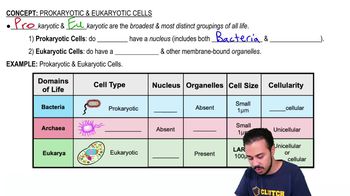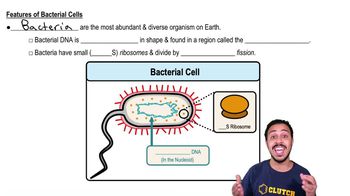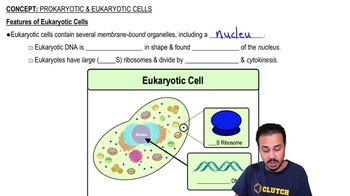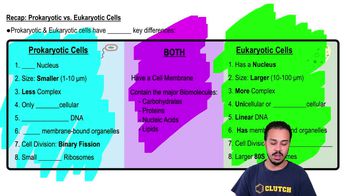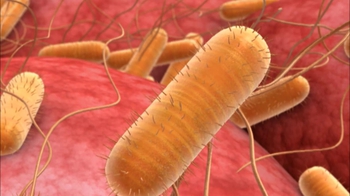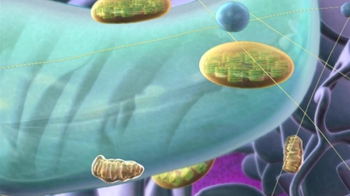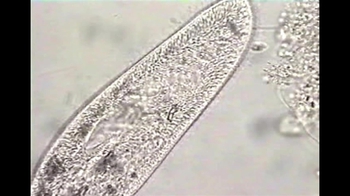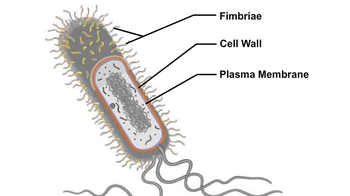Table of contents
- 1. Introduction to Biology2h 42m
- 2. Chemistry3h 40m
- 3. Water1h 26m
- 4. Biomolecules2h 23m
- 5. Cell Components2h 26m
- 6. The Membrane2h 31m
- 7. Energy and Metabolism2h 0m
- 8. Respiration2h 40m
- 9. Photosynthesis2h 49m
- 10. Cell Signaling59m
- 11. Cell Division2h 47m
- 12. Meiosis2h 0m
- 13. Mendelian Genetics4h 44m
- Introduction to Mendel's Experiments7m
- Genotype vs. Phenotype17m
- Punnett Squares13m
- Mendel's Experiments26m
- Mendel's Laws18m
- Monohybrid Crosses19m
- Test Crosses14m
- Dihybrid Crosses20m
- Punnett Square Probability26m
- Incomplete Dominance vs. Codominance20m
- Epistasis7m
- Non-Mendelian Genetics12m
- Pedigrees6m
- Autosomal Inheritance21m
- Sex-Linked Inheritance43m
- X-Inactivation9m
- 14. DNA Synthesis2h 27m
- 15. Gene Expression3h 20m
- 16. Regulation of Expression3h 31m
- Introduction to Regulation of Gene Expression13m
- Prokaryotic Gene Regulation via Operons27m
- The Lac Operon21m
- Glucose's Impact on Lac Operon25m
- The Trp Operon20m
- Review of the Lac Operon & Trp Operon11m
- Introduction to Eukaryotic Gene Regulation9m
- Eukaryotic Chromatin Modifications16m
- Eukaryotic Transcriptional Control22m
- Eukaryotic Post-Transcriptional Regulation28m
- Eukaryotic Post-Translational Regulation13m
- 17. Viruses37m
- 18. Biotechnology2h 58m
- 19. Genomics17m
- 20. Development1h 5m
- 21. Evolution3h 1m
- 22. Evolution of Populations3h 52m
- 23. Speciation1h 37m
- 24. History of Life on Earth2h 6m
- 25. Phylogeny2h 31m
- 26. Prokaryotes4h 59m
- 27. Protists1h 12m
- 28. Plants1h 22m
- 29. Fungi36m
- 30. Overview of Animals34m
- 31. Invertebrates1h 2m
- 32. Vertebrates50m
- 33. Plant Anatomy1h 3m
- 34. Vascular Plant Transport1h 2m
- 35. Soil37m
- 36. Plant Reproduction47m
- 37. Plant Sensation and Response1h 9m
- 38. Animal Form and Function1h 19m
- 39. Digestive System1h 10m
- 40. Circulatory System1h 57m
- 41. Immune System1h 12m
- 42. Osmoregulation and Excretion50m
- 43. Endocrine System1h 4m
- 44. Animal Reproduction1h 2m
- 45. Nervous System1h 55m
- 46. Sensory Systems46m
- 47. Muscle Systems23m
- 48. Ecology3h 11m
- Introduction to Ecology20m
- Biogeography14m
- Earth's Climate Patterns50m
- Introduction to Terrestrial Biomes10m
- Terrestrial Biomes: Near Equator13m
- Terrestrial Biomes: Temperate Regions10m
- Terrestrial Biomes: Northern Regions15m
- Introduction to Aquatic Biomes27m
- Freshwater Aquatic Biomes14m
- Marine Aquatic Biomes13m
- 49. Animal Behavior28m
- 50. Population Ecology3h 41m
- Introduction to Population Ecology28m
- Population Sampling Methods23m
- Life History12m
- Population Demography17m
- Factors Limiting Population Growth14m
- Introduction to Population Growth Models22m
- Linear Population Growth6m
- Exponential Population Growth29m
- Logistic Population Growth32m
- r/K Selection10m
- The Human Population22m
- 51. Community Ecology2h 46m
- Introduction to Community Ecology2m
- Introduction to Community Interactions9m
- Community Interactions: Competition (-/-)38m
- Community Interactions: Exploitation (+/-)23m
- Community Interactions: Mutualism (+/+) & Commensalism (+/0)9m
- Community Structure35m
- Community Dynamics26m
- Geographic Impact on Communities21m
- 52. Ecosystems2h 36m
- 53. Conservation Biology24m
5. Cell Components
Prokaryotic & Eukaryotic Cells
Problem 5`
Textbook Question
Which of the following cell structures would you expect to be most important in the growth of bacteria on the surface of your teeth?
a. Cell wall
b. Fimbriae
c. Flagella
d. Cilia
 Verified step by step guidance
Verified step by step guidance1
Understand the function of each cell structure option provided: cell wall, fimbriae, flagella, and cilia.
Cell walls provide structural support and protection, but are not directly involved in attachment to surfaces.
Fimbriae are hair-like structures that allow bacteria to adhere to surfaces, which is crucial for growth on teeth.
Flagella are tail-like structures used for movement, not attachment, so they are less relevant for bacteria adhering to teeth.
Cilia are similar to flagella but are typically found in eukaryotic cells, not bacteria, and are used for movement rather than attachment.
 Verified video answer for a similar problem:
Verified video answer for a similar problem:This video solution was recommended by our tutors as helpful for the problem above
Video duration:
2mPlay a video:
Was this helpful?
Key Concepts
Here are the essential concepts you must grasp in order to answer the question correctly.
Fimbriae
Fimbriae are hair-like appendages on the surface of bacterial cells that enable them to adhere to surfaces, such as the enamel of teeth. This adhesion is crucial for bacteria to colonize and form biofilms, which are communities of bacteria that contribute to dental plaque formation. Understanding fimbriae is essential for recognizing how bacteria establish themselves in the oral cavity.
Recommended video:
Guided course

Fimbriae
Biofilm Formation
Biofilms are structured communities of bacteria that attach to surfaces and are embedded in a self-produced extracellular matrix. In the context of dental health, biofilms on teeth can lead to plaque formation, which is a precursor to cavities and gum disease. The ability of bacteria to form biofilms is a key factor in their growth and persistence on teeth surfaces.
Recommended video:
Guided course
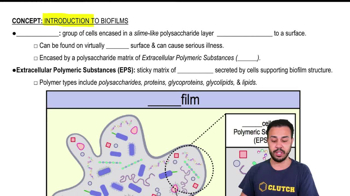
Introduction to Biofilms
Bacterial Adhesion
Bacterial adhesion is the process by which bacteria attach to surfaces, a critical step in colonization and biofilm formation. This process often involves specific structures like fimbriae, which facilitate the initial attachment to surfaces such as teeth. Understanding bacterial adhesion helps explain how bacteria can persist in the oral environment and contribute to dental issues.
Recommended video:
Guided course
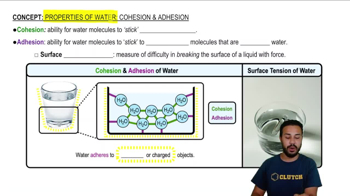
Properties of Water- Cohesion and Adhesion

 5:54m
5:54mWatch next
Master Prokaryotic & Eukaryotic Cells with a bite sized video explanation from Jason
Start learningRelated Videos
Related Practice

